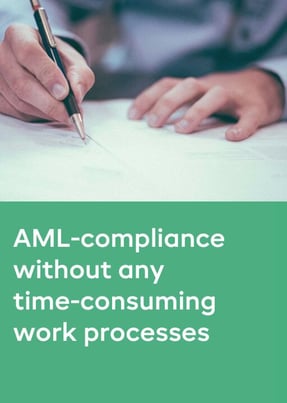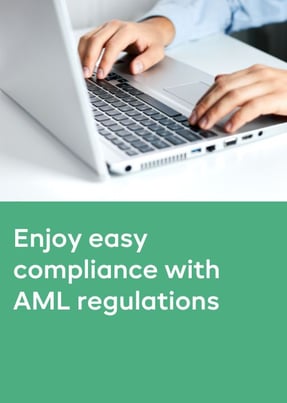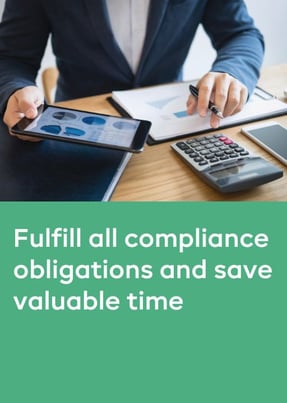- Products
- RegLab for ...
- Knowledge centre
Download the AML glossary >
 Discover the essential AML compliance terminology and gain instant access to a comprehensive guide
Discover the essential AML compliance terminology and gain instant access to a comprehensive guide - The company
Working at RegLab >
There may not be any vacancies that perfectly match your profile, but that does not mean there is no room for someone who can improve RegLab.
- Book a demo
Have AML procedures been drawn up?
Question no. 4 from the supervisor
This article expands on the previous article on question no. 3 from the supervisor: "Does your office have a written risk policy?" This blog post will go into more detail about these procedures. How do you put these processes into practice and what do you show during an audit (AML protocol, Articles 2a, b and c of the AML)?
Visualisation is a plus
In the previous article, we discussed the importance of drafting a risk policy. In this policy you describe the procedures. Basically, how does your office deal with the AML policy and what steps do you take when? I already indicated that visualising processes can be extremely helpful. A written procedure, with different processes, is not a simple document to use. Visuals, such as infographics and flowcharts, are highly recommended to make employees think in a process-oriented way within your office. These can also be used as a handy reference work at the office.
AML as a chore
Many lawyers we speak to feel AML is a chore. Basically, it is not something they are particularly passionate about. For this reason, we see a variety of ways in which AML is approached in offices. Some lawyers take it very seriously and prefer to handle all procedure steps themselves, others prefer to engage support staff.
Keep in mind supervisors feel the lawyer themselves are responsible for the AML policy and its implementation. Obviously, a secretary can easily take various steps, as long as the lawyer in question carries out a check. This is also important for the 4-eyes principle. A support staff member is perfectly capable of taking on the identification process. Assessing whether an unusual transaction is involved, however, is the responsibility of the lawyer in question. This requires proper understanding of the file concerned. Therefore, make sure that within the AML procedures, it is clearly described who is responsible for what and who should forward what, when (and to whom). Make sure roles are by no means mistaken.
Consistency and uniformity within the procedures established by your office are important to the supervisor. He/She wants to see that everyone in the office implements the policy in the same way. This automatically means that the AML process is organised more efficiently. The crucial element here is this: provide specialists internally, make them recognisable and give them a mandate. This should be crystal-clear, make sure the process is workable. Do not make it too complicated, because you have to be able to comply with it.
Also, regularly show the progress at the office. Make files transparent. Ensure a high degree of transparency, e.g. stating which files are (still) missing some necessary documents. You can keep track of this in software applications (e.g. RegLab), but you can also start with an Excel list, for example. Here you can register how many new clients have been added during that period, who the lawyer is dealing with it and what is still in progress. You should discuss this list internally on a regular basis.
Risk Qualification
Always take a critical look at risk qualification. State when and how you start and conduct research as an office. Based on which criteria do you opt for a simplified, regular or enhanced investigation? These are some of the answers supervisors would like to see reflected in the procedures.
Writing down policy procedures...
Describing procedures takes a lot of time. There are many exceptions and elaborating them is exactly what involves a demanding process. So here are some simple tips:
- Assemble a project group (don't do this alone).
- Define the actions and distribute them.
- Appoint (super) specialists (and provide training).
- Keep the procedures as practical as possible, think of centralization.
- Work out the processes in visuals.
- Make sure that the basic steps are clear for every. If matters become more difficult or complex, make sure they can be presented to the (super) specialists.
- Involve an advisor who can help design and implement policies and procedures as efficiently as possible.
If you prefer not to do this independently and if you are looking for someone to help you describe your policy and implement procedures, address RegLab’s team of specialists. We will also assist you in designing processes in visuals.
Themed file: fully prepared for the supervisor’s audit
This article is part of a number of articles and downloads that will help you prepare yourself for the supervisor’s visit. This content is based on a supervisor's FAQs during an audit. Do you want to be 100% AML-proof and ready for the supervisor’s visit? Find all FAQs in our Knowledge Centre.





